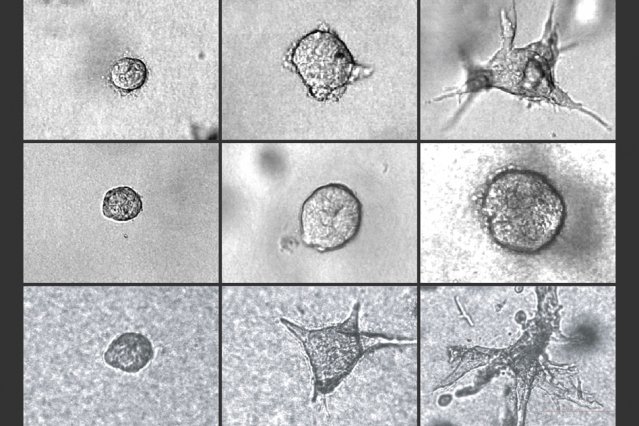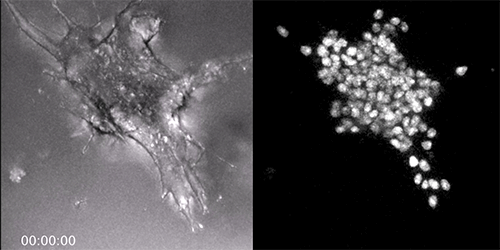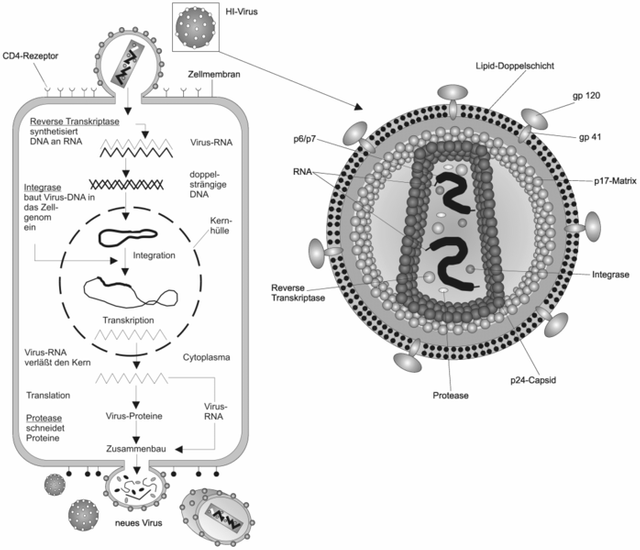Comparing the notoriety of the two harbingers of death - HIV/AIDs and Cancers
Lately, I have been trying to get some answers to a question I feel worth asking. Reason been that, both harbingers have increased mortality rate over the years. I intend to compare both cancer and HIV and possibly try to establish basis if any, as to which is more notorious in causing death. One might be tempted to give immediate answer but without critical analysis, your answer might just be a mere guess with no strong bases. In this article, I also intend to do justice to both life threatening diseases and at the same time critically explore their notoriety in causing death. Join me on this as it promises to open your eyes more to things you probably don't know.
First of all, let's get a little grip of what cancer and HIV/AIDS is all about.
HIV/AIDS
HIV stands for Human Immunodeficiency Virus the name alone tells us that it deals severely with the immune system. HIV is a retrovirus (meaning it stores its genetic information as RNA and has the ability of using the RNA to produce its DNA machinery for replication once inside a living host) and remains viable in the the infected person as long as the person is alive - one of the reason why infection with HIV has no cure for now.
On their own, they cannot survive, rather this virus has high affinity for a type of cell which play a huge role in human immune system known as the CD-4 cells (Cluster of Differentiation 4 cells). The CD4 cells are a type of white blood cells that play crucial role in ensuring that the body maintains strong and healthy immune system by responding to infection. The HIV virus has a very strong attraction to the CD4 cells. In due course, you will find out why of all cells in the body, why the CD4 cells.
The HIV virus infection leads to what is known popularly as AIDS (Acquired immune deficiency syndrome). A stage in the disease where death is a result of acquired infections. Even ordinary little disease or ailment that on a normal, cannot kill a human being, becomes deadly. The mysteries behind this will be unraveled later. Lets continue, shall we!
Now you have gotten an inkling about HIV/AIDS, let's talk little about cancer.
CANCERS
I am sure you must have one way or the other heard about cancer. The simplest definition of cancer is that, it is an uncontrolled abnormal growth of cells in the body. Cells in the body are subject to regulatory mechanism and checkpoints during cell division but in a situation where these check points and regulators are absent or altered due to one reason or the other, for example due to mutation (an alteration in the genetic make up of a living organism) , this results to uncontrolled division and growth.
They could also be called malignacies or tumours (an aggregation of abnormal cells). Don't get it twisted, all cancers usually form tumours but not all tumours are cancerous. A tumour that is not cancerous is referred to as a benign tumour. So bear in mind that not all swellings are cancers. The well known type of cancers include carcinoma (those that arise from glands and organs such as the skin, breast, pancreas and the lungs.
Others are lymphoma (those that affect the lymphocytes), leukemia (cancer of the red blood cells), Sarcoma (cancers that affect connective tissues of the body such as the bone, muscle, fats and cartilages) and Melanoma those that affect the pigmentation of the skin. Nothing is more important to a patient in the hospital with a tumour than being told that his / her swelling is benign and not malignant. The sigh of relief unimaginable.
Now you have basic understanding of what HIV/AIDS and cancer is, lets now go into the main discussion.
The Virulence and Invasiveness
The virulence of HIV
The term virulence simply means the degree of disease causing ability of an infectious agent.
HIV is one heck of a virus that has so far defied science through its non availability of drug for permanent cure. HIV virus just as earlier said, has high attraction for CD4 cells or T-helper cells that play major role in protecting the body system against infection. The major reason why HIV is more attracted to the helper T cells is because the helper T cells have a surface receptor to which the HIV can bind to.
It's common to say that HIV is transmitted through sexual intercourse but do you actually know the mechanism through which this happens? Directly, they easily enter the body system through blood to blood contact but through sexual contact, it's a different scenario.
The mucous membranes on the wall of the vagina, rectum are endowed with a lot of CD4 cells, HIV infects these cells and through this means, you get infected. In the same vein, dendritic cells (major antigen presenting cells on skin surface that primarily capture infectious agents e.g HIV and transport them to the lymph node where other immune cells especially the T cells are activated. The replication of the virus thus begins in the lymph nodes and during this stage, the virus is not detectable. A virus undetectable at this point is equally untransmitable, bear this in mind.
On what basis is the virulence?
The virulence of HIV is based on its ability to invade and take over the genetic machinery of the host cell. Generally, cells that have CD4 receptors on their surfaces are attacked by HIV. Examples include the Dendritic cell, macrophages, monocytes and lymphocyte - T-cells. Upon entry into the blood, with their GP120 glycoprotein spike, they lock onto the CD4 receptors on the T helper cells and in order to ensure that the attachment is stable, a co-receptor either CCR5 or CXCR4 is also engaged. It then uses its GP41 protein to fuse its envelop with the cell wall of the T helper cell. This singular action then allows the capsid of the of the HIV to enter the T- cell.
Once inside, they take over the T cells and use their genetic machinery to produce more HIV. Another fascinating thing about HIV is that, they are are highly evasive (that is, they have the ability of circumventing the host immune system). How on earth do they do this?
Why HIV is not curable up till date
HIV integrates itself into the DNA of human immune system cells and only replicates when the cell is stimulated to respond to an infection. These cells are called latently-infected cells. These cells are not recognised as infected by the immune system and killed off, allowing them to persist for as long as the cell lives.
You can only regulate its replication with anti-retroviral drugs but you cannot remove it from the body. This is the main reason why they say it has no cure. It continues to attack and damage CD4 cells until their levels are significantly low thus, leaving the bloody vulnerable to opportunistic infections. A state regarded as Acquire immune deficiency syndrome (AIDS). Bear in mind that AIDS is the most critical stage of HIV infection and it also regarded as the stage 3. More reason why most patients with long HIV history suffer opportunistic infections (infections as a result of weakened immune system) like Tuberculosis, herpes simplex virus 1, salmonella, toxoplasmosis, candidiasis etc
Effects of drugs
Drugs produced only target specific stages of the virus replication so as to inhibit them. A simple block in the CCR5 or CXCR4 receptors by drugs for example, automatically inhibits infection of the CD4 cells by HIV. A viral load above 100,000 copies/ml is tantamount to speedy reduction in the CD4 cells. Test done to detect HIV, targets the presence of the HIV antibody and the HIV P24 antigen. In all, administration only help to reduce to viral load and consequently increase the CD4 cell counts in the patient, so as to boost the immune system in a bid to prevent opportunistic infections.
Without treatment, death as a result of AIDS is certain and inevitable. Due to advancement in science and medicine, the development of drugs has gone a long way to keep HIV patients healthy and strong. Earlier before now, it was believed that infection with HIV is death sentence, the reverse is the case now. With anti retroviral drugs, one can still live a normal life, healthy and strong.
Haven said all the above about HIV, are the explanations enough to tag HIV and the most notorious? Let's quickly delve into the world of another harbinger of death - Cancer
Cancer invasiveness
Cancer on the other hands as we have established earlier, is an uncontrolled abnormal growth of cells. They are generally cells that are independent of any regulatory mechanism in the system. Both HIV and cancer funny enough share some similarities and one of which is that they could be both highly invasive. The invasiveness of a pathogen makes it much more dangerous because, they will continue to attack healthy and normal cells until they have full dominance over the host.
 Tumour invasionMITImage credits : Lu Yong Han
Tumour invasionMITImage credits : Lu Yong HanA close look at the picture above in the last row, tells us that the cells is changing in conformation into a star like shape with spikes, typical of metastatic tumours. They burst later and spread to neighbouring cells.
Recent research has shown that the water content of a tumour determines the invasiveness of the cancer cell. The cells that are more stiffer and with less water content , tend not to burst and invade other cells unlike when its exterior ends are soft and filled with much water content. Could this be a way out or be used as a bench mark to determine the invasiveness of a cancerous growth?
Metastatic capability of cancers cells
Cancerous cells have a unique attribute of metastasizing (the ability to spread, move and invade other healthy cells. Unlike the HIV, cancerous cells do not necessarily need to take take over the genetic machinery of a heathy cell, rather because of their hyper proliferation (rapid and fast multiplication), they displace healthy cells. They also deprive healthy cells necessary nutrients required for proper functioning thus leading to death.
A classical and simple example is breast cancer. About 80% of breath cancers are highly invasive and metastasizes. The gif below shows a cancerous cells at its late stage ready to burst and spread to surrounding cells. A typical characteristic of an invasive cancerous cell.
 Late stage of an invasive cancerous cell.MIT.Image credit: MIT researchers
Late stage of an invasive cancerous cell.MIT.Image credit: MIT researchersAnother reason for their easy invasiveness is the abundance of lymph nodes around the chest region when related to breast cancer. This lymph nodes enable and facilitates to easy spread of cancers. Another typical example is cervical cancer. The abundance of lymph nodes plays a critical role in the spread of cancerous cells in the cervix. It's very obvious that lymph node as very significant role to play in neoplasia (new growth).
If you would recall, in the discussion about HIV, lymph node also play an important role in their replication at the early stage of infection. It's obvious that both HIV and cancerous cells have special interest in lymph node.
Another unique feature about cancerous cell is Angiogenesis (development of new blood vessels). Cancer cells are well known to posses the ability of producing blood vessels in a bid to compensate or supplement their hyper activity. The more blood vessels are produced, the more nutrients they assimilate for growth. This goes to say that, cancerous cells are not so entirely dependent as they could help themselves. Unlike HIV that solely depends on viability of other cells like the CD4, cancerous cells need not rely on others cells for replication.
The replication of cancer cells is so independent because they bypass regulatory checkpoints. Chemotherapies are aimed at totally eliminating cancerous cells but this also comes with some negative effects as most chemotherapeutic treatment cannot differentiate between healthy and an unhealthy cell. This means that, you cannot kill the cancerous cell without harming healthy cells in one way or the other.
This is another area where cancer poses serious threat. Operation is one of the way to remove cancerous growths provided they are not highly invasive. For treatment to be successful, most cancers are better detected and removed at their early stages. Failure to do this, death is certain and inevitable.
The hallmark!
In all, it still points to the fact, early detection is the key to survival. Both disease are not human friendly and as such prevetion is better than cure. Eat healthy, exercise, keep fit, go for breast scan. A tumour that last for more than a week with serious pain is worth examining. Go for check ups.
References
•lymph node and cancer
•opportunistic infections
•CDC-living with Ois
•Cell stiffness tumour metastisize
•How HIV attach to a host
How HIV infects the body

.jpg)

This post has been voted on by the SteemSTEM curation team and voting trail. It is elligible for support from @curie and @minnowbooster.
If you appreciate the work we are doing, then consider supporting our witness @stem.witness. Additional witness support to the curie witness would be appreciated as well.
For additional information please join us on the SteemSTEM discord and to get to know the rest of the community!
Please consider using the steemstem.io app and/or including @steemstem in the list of beneficiaries of this post. This could yield a stronger support from SteemSTEM.
Congratulations @cyprianj! You have completed the following achievement on the Steem blockchain and have been rewarded with new badge(s) :
You can view your badges on your Steem Board and compare to others on the Steem Ranking
If you no longer want to receive notifications, reply to this comment with the word
STOPVote for @Steemitboard as a witness to get one more award and increased upvotes!